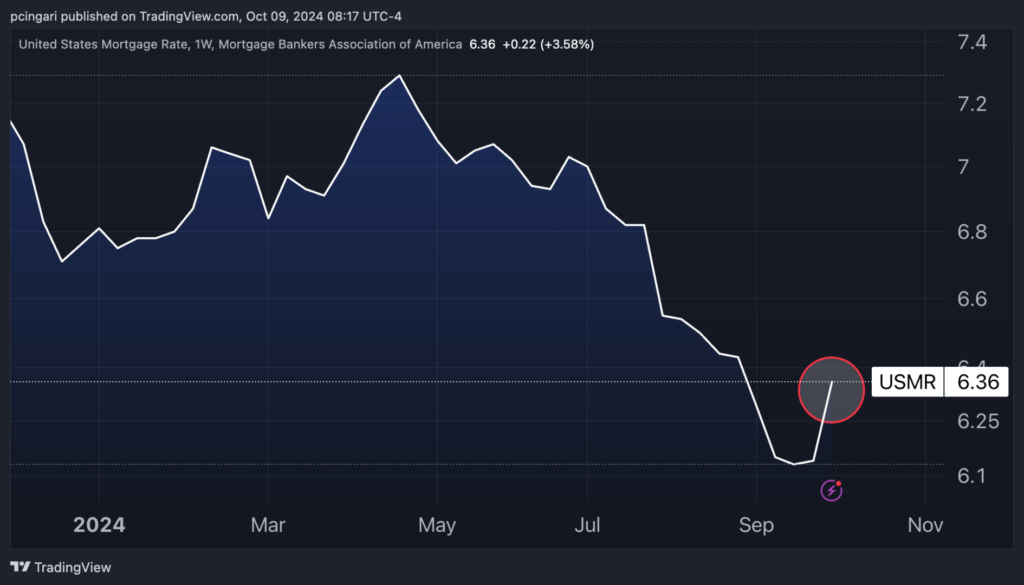Mortgage Rates Make Dramatic U-Turn, Freezing Homebuyers: Applications Fall 5% As Markets Rethink Fed Policy

A sharp reversal in mortgage rates has taken U.S. homebuyers by surprise, leading to the largest drop in weekly mortgage applications since mid-August.
The sudden uptick in rates adds pressure to an already challenging housing market, where affordability and supply are becoming increasingly elusive for prospective buyers.
Mortgage Rates Climb To Highest Levels Since August
The average interest rate for a 30-year fixed-rate mortgage on conforming loans (under $766,550) jumped 22 basis points to 6.36% in the week ending Oct. 4, according to the latest Mortgage Bankers Association (MBA) report.
This marks the highest level since August and represents the largest weekly jump in 30-year rates since April 2024.
For context, just a week earlier, the average rate stood at 6.14%, a level that mirrored the lows seen back in September 2022. This sudden surge in borrowing costs has cooled demand as mortgage rates climbed in tandem with Treasury yields.
In the same week, rates for jumbo loans (those exceeding $766,550) also rose, hitting 6.64%, a 14-basis-point increase from the previous week.

Mortgage Applications Drop Across The Board
As a result of the spike in mortgage rates, the demand for home loans sharply declined.
Overall mortgage applications dropped 5.1% in the first week of October, extending the previous week’s 1.3% decline. This back-to-back pullback trimmed a significant portion of the nearly 30% increase in mortgage demand seen in September.
Applications for home refinancing, which are more sensitive to short-term rate changes, plummeted by 9% from the previous week.
Jobs Report Sparks Rethink On Interest Rates
The primary driver of the recent rate spike was the unexpectedly robust September jobs report, which exceeded market expectations and pushed Treasury yields higher.
Last month, the U.S. economy added 254,000 nonfarm payrolls, well above the forecasted 140,000. Furthermore, the unemployment rate dipped to 4.1%, while wages grew faster than anticipated, signaling a labor market that remains hotter than expected.
"Across every dimension, the September employment report showed a job market that was stronger than expected," said Mike Fratantoni, chief economist at the MBA.
He added that while the data could support a “soft landing” for the economy, it also raises concerns about inflation’s persistence. The strong labor market suggests the Federal Reserve may not need to cut rates as quickly as many had hoped.
Market Reactions: Treasury Yields Spike, Mortgage-Linked Stocks Fall
Following the strong jobs data, traders revised their expectations for Federal Reserve policy.
Before the report, many had anticipated a potential back-to-back 50-basis-point rate cut in November. However, the latest labor developments have completely wiped out those expectations.
Investors are currently assigning an 87% chance of a 25-basis-point cut, while the remaining odds are for a no-rate cut scenario, as per the CME FedWatch tool.
The 30-year Treasury yield, which often serves as a barometer for mortgage rates, jumped by 15 basis points last week to 4.30%. Meanwhile, the 10-year yield also breached the 4% threshold, something investors hardly expected just weeks after a sizable Fed rate cut.
Mortgage-linked stocks took a hit, pressured by rising bond yields. The VanEck Mortgage REIT Income ETF MORT dropped nearly 5% last week and is down an additional 0.8% this week. Meanwhile, the iShares Residential and Multisector Real Estate ETF REZ slid almost 3% last week and has fallen another 1% so far this week.
Mortgage Rates Outlook: What's Next?
Looking ahead, the MBA forecasts that longer-term rates, including mortgage rates, will stay within a relatively narrow range over the next year.
Though this recent spike has brought rates to the higher end of that range, the MBA predicts mortgage rates will remain close to 6% for much of the next 12 months.
However, any future surprises in inflation or economic data could disrupt this outlook. If Treasury yields continue to rise, mortgage rates may follow suit, further straining affordability for homebuyers and applying more downward pressure on housing demand.
Read Next:
Image created using artificial intelligence via Midjourney.
© 2024 Benzinga.com. Benzinga does not provide investment advice. All rights reserved.
source
Breaking news
See all






